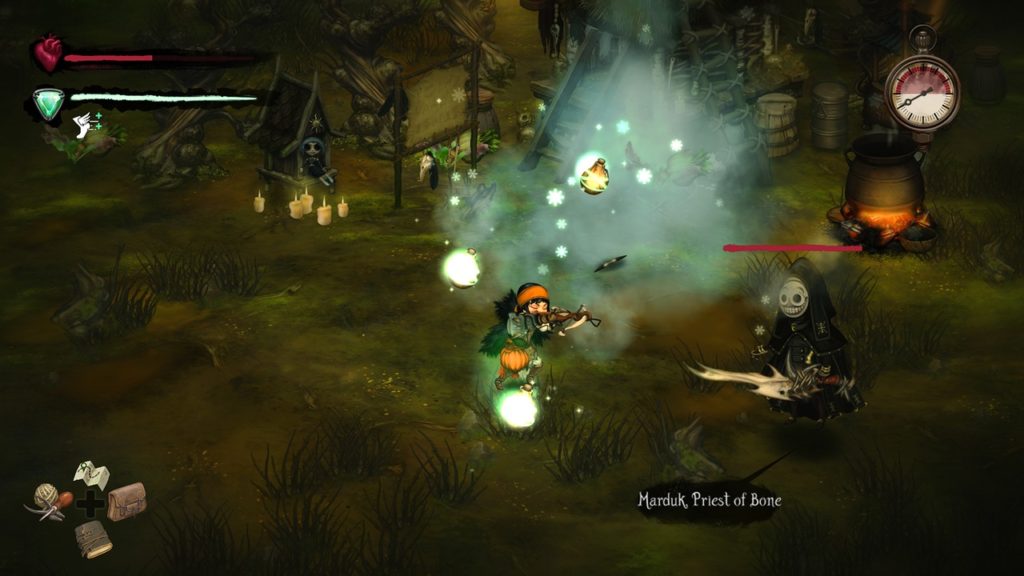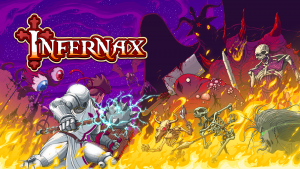
Smoke and Sacrifice, an Indie game developed by the small studio Solar Sail Ltd, is a fresh take on the RPG genre. You play as Sachi, a mother who lost her son to her village’s sacrificial practices, who embarks on a quest after finding out that her child may not be gone. Through relatively simple gameplay and an engaging story, Solar Sail has managed to create an independent game that excels on almost every front.
Smoke and Sacrifice is a visually pleasing experience. The top-down view gives players a good look at the beautiful environments, brought to life in a phenomenal painterly art style. There is minimal clutter; NPCs, foliage, buildings, etc, are all easily differentiated on-screen, resulting in an intuitive aesthetic that allows players to easily distinguish items that can be interacted with. The lack of visual noise results in an easy-to-parse game world that many “2.5D” or pseudo-isometric games struggle with.
NPC design is one of the game’s strongest aspects. Ever wanted to fight a cross between a pug and bear? You’ll see some in the first few minutes! Have you dreamed of encountering an exploding land jellyfish, a vulture raptor, a unicorn yak? All of these creatures and more can be found in Smoke and Sacrifice, brought to life with impressive artistic skill. And it’s not just limited to monsters, humanoids in Smoke run the gamut from villagers to cultists to plague doctor-esque harvesters, all rendered in great detail. The heavy gothic influence in the world design translates into a dreary yet not cynical setting; there’s always an element of hope to the situation Sachi finds herself in.
As Sachi you will explore many different locales and biomes, discovering new creatures along the way. Every item you find has its own uses; every animal or monster you find can have its remains used for your benefit. The sheer amount of NPCs adds a great amount of variety to an already well-crafted world.
The story itself is mysterious tale about Sachi’s hunt for her long-lost son. Straightforward in its presentation, the story does not pad itself; you can go through it at the pace of your choosing. Solving the mystery of the enigmatic religion that sacrificed your son never feels like a chore, there is always just enough of a hook to keep you going without constraining your freedoms. Conversations are simple and short, rarely disclosing unnecessary information. The cadence of the narrative can seem fast as a result, but as long as the player shows even a passing interest in the side-quests the game will not feel rushed. The plot may be simple, but it is nevertheless still captivating; despite the overly-concise nature of the dialogue and the lack of voice-acting, the writing still does a good job of making the player care about Sachi and her journey. Whether confronting mysterious priests or slaying monsters in a suit of armor made of fur and bone, Sachi feels like a real, consistent character.

Crafting is deep and involved. Many environmental hazards and enemies are more easily handled by creating the right equipment. There are areas that are impossible to progress through without certain items, some of which have to be periodically replaced. This system does, however, highlight the game’s weakest aspect: inventory management. With minimal control over sorting and the view of your bag, playthroughs can get confusing very fast. Most important items degrade over time, resulting in an endgame that is filled with micromanaging equipment of varying durability, especially given the number of items most players will find themselves using to survive.
And surviving can range from quite easy to extremely difficult; you never truly know what this game will throw at you. A simple combat system is used for enemy encounters. This is rather fitting for this style of game and did not bother me much, but for players who tire of “dodge, hit, dodge” fighting, you may want to take a closer look at the game before jumping in. Combat may start with you holding nothing but a lantern and your fists, but you soon find yourself with a lot of variety to choose from with many different weapons and armor available for crafting. In terms of encounters, enemies can one-hit you, or do scratch damage. Environmental hazards can take out half your vitality before you’ve even realized you’ve touched one. It’s a game that can constantly keep you on edge with how deadly it can be; its whimsical art style lulling you into a false sense of security.
When not fighting or exploring, you will most likely be gathering sticks, stones, talking books; standard survival crafting fare. There are a wealth of items to create, some more important than others. NPCs often provide hints as to where the story will go next, or what items Sachi needs to craft to progress, but they are never an overbearing presence in the story. Few scripted encounters can be found in Smoke and Sacrifice, resulting in an experience that is great for the gamer who swings between exploration and story progression, like myself.
There are a small amount of technical issues that may impede the experience, however. There is no borderless windowed option, and on my machine attempting to tab out of the program in fullscreen mode resulted in a black screen that lasted several seconds, something that has not happened with other games. Another issue was that some items that drop in the world may become unable to be clicked due to their positioning on or behind other objects, which was very apparent the first time I encountered the massive pugbears. Interacting can also be inconsistent due to the camera angle; I have clicked on some items only to result in Sachi walking past it or using a different nearby item. Finally I also had issues with achievements not unlocking. These issues, however, were few and far between; they did not detract from a great experience.
Smoke and Sacrifice is a well-made game presenting a unique indie take on the survival RPG. The meandering difficulty may not be for everybody, but the experience of fighting through this steampunk fantasy world to rescue Sachi’s son was a memorable one. A small collection of bugs and odd design choices may keep the game from being truly exceptional, but only just.
Score: 9.0/10







